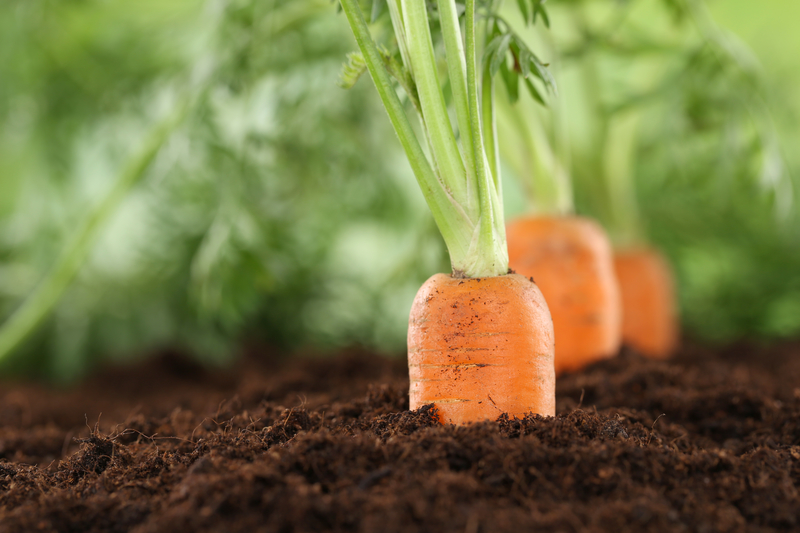If you feel as though you have enough orange in your yard, then try growing purple, white, red or yellow carrots. They’re all one in the same so don’t be intimidated by their color! The carrots can be planted, harvested and stored by following a simple 7-step process:
Quick Guide
- Carrots prefer soil pH between 5.5 and 6.8. Above 6.0 is better.
- Soil should be rich in organic matter, but avoid excessive nitrogen.
- Plant carrots in full sun for best production. Plants will tolerate late shade.
- Carrots prefer loose, well drained soil.
- Space plants 2″ apart within rows, with rows 6-8″ apart in a block style planting.
- Apply an organic mulch to keep soil cool and control weeds.
- Water regularly if rains fail.
- Harvest when carrots reach desired size, or before heavy frost.
Step by Step Instructions
#1 – Prepare your soil
The best soil for carrots is deep and free of rocks and heavy clay. If you have light, fluffy garden soil in good condition, you're good to go with a little compost or rotten manure mixed in at planting time. If your soil is heavy or rocky, you'll want to do a little more preparation. Carrots do best with at least nine inches of easy to penetrate soil.
#2 – Planting Carrots
The best time to plant carrots is once the soil has warmed. Soil temperatures around 45°F or lower will slow down or stop germination.
Plant carrot seeds about 1/4″ to 1/2″ deep. I'll often make a shallow trench with my fingertip. Sprinkle the seeds roughly 1/2″ apart down the trench (thicker for older seeds). Cover gently and water lightly to settle the soil. If soil is heavy, cover seeds with compost to make it easier for the seedlings to break through.
You can continue to plant carrots at roughly two week intervals up to about mid-July for extended harvests.
#3 – Help Your Carrots to Sprout
Ideally, your seed bed should stay moist until the carrots germinate. If you don't have rain, water gently every day or two. Be patient – it may take up to three weeks for seedlings to appear.
Some folks cover their planting beds with burlap and water right through the burlap to help retain moisture. Remove the burlap at the first sign of green sprouts. If it is very windy or dry, I'll use burlap.
#4 – When to Thin Carrots
I usually do my first thinning when carrots are two to three inches tall. At this point I aim to have them about one inch apart, and toss the mini greens into my salad. They taste a something like parsley. About three weeks later you can thin again, leaving the plants spaced two to three inches apart to finish growing. Alternatively, you can thin to two to three inches at the first thinning.
I usually pull my extra carrots, but if plants are very thickly planted, snipping off the extra might be safer. Pulling closely growing carrots might lead to pulling up the carrots you want to keep.
#5 – Care During the Growing Season
Once thinning is complete, apply an organic mulch such as grass clippings or straw to moderate soil temperature and moisture. Water if needed to keep soil moist.
#6 – Harvesting
As mentioned above, you can start snacking on the thinnings, but the main crop won't be available for at least a couple of months.
If soil is loose and moist, you may be able to pull up carrots by the tops. When soil is hard or compacted, loosen gently with a fork before lifting out carrots. If you accidentally skewer a carrot, use or process it shortly after harvest.
When gathering carrots, take carrot to avoid getting the juices from the carrots tops on your bare skin. The sap can cause phytophotodermatitis. Symptoms include painful rash and blisters.
#7 – How to Store
For root cellar storage, cull any damaged roots. Snip carrot tops to roughly one inch in length. Brush off excess soil. Pack carrots in layers in damp sawdust or leaves in a box or bin. Try to avoid having the roots touch. Do not store carrots near apples, as the ethylene gas from the apples may cause sprouting and off flavors in the carrots.
Alternatively, wash carrots and trim tops. Store in a plastic bag with the top open in the crisper drawer of your refrigerator. Best if used within a few months.
Carrots can also be frozen, dehydrated, freeze dried or canned in a pressure canner. It is not safe to can carrots in a water bath canner because they are low acid.
If you would like to store your carrots, look for varieties that are specifically recommended for storage.
Carrot Q & A
What's the Best Carrot Seed?
Try to use your carrot seeds within 1-3 years of purchase, and plant them more thickly in later years. Keep unused seeds in a cool dry location, out of direct sunlight.
What are good companion plants for carrots?
- onions
- chives
- caraway
- coriander
- calendula
- chamomile
- swan river daisies
Are there fast growing carrots?
Yes. Look at the “date to maturity” on package or catalog listing. Smaller varieties like Minicore, Bambino and Parisian mature in 55-60 days.
My Carrots are Bumpy and Strange Looking – are they Safe to Eat?
Carrots grown in rough ground and some varieties of carrots will naturally develop bumps, forks and other odd looking bits. Don't fear the funky veggies!
Have you grown carrots in your garden? Do you have any advice for first-time planters?
Article Source: Common Sense Home

This is the one vegetable that I have never been able to grow.
Ditto…
Ruth Chamberlain